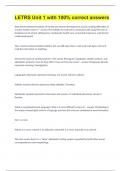LETRS Unit 1 with 100% correct answers
Why did the National Institute of Health and Human Development classify reading difficulties as
a major health concern? - answer The inability to read well is associated with social ills such as
dropping out of school, delinquency, inadequate health care, unwanted pregnancy, and chronic
underemployment.
They cannot read prescription bottles, but can still open them, cant read road signs, and cant
read the instruction on anything.
Discuss the types of writing systems in the world. (Pictogram, logograph, syllabic symbols, and
alphabetic symbols). How do they differ? How are they the same? - answer Pictograms-directly
represent meaning, hieroglyphics.
Logographs-abstractly represent meaning, not sound, Chinese radicals.
Syllabic symbols-directly represent whole syllables, Cherokee.
Alphabetic symbols-represent consonants and vowels, or individual phonemes, Greek or
Russian.
What is morphophonemic language? Why is it more difficult to learn it? - answer Morphology is
the study of meaningful units in a language and how the units are combined in word formation.
Nat- is a root.
Nature is a noun; natural is an adjective; naturalist is a noun; naturally is an adverb.
This also means that it is a "deep" alphabetic writing system organized by both letter-sound
correspondences and morphology.
,How do oral language and written language differ? - answer Speaking is natural, reading and
writing are not.
Spoken language is "hard-wired" inside the human brain.
Oral language is the foundational skill for later reading and writing.
Discuss the terms phoneme, morpheme, and grapheme giving examples of each..? - answer
Phoneme-units of sound in a specified language that distinguish one word from another (p,b,d,
and t in English words pad, pat, bad, and bat.)
Morpheme-unit of language that cannot be further divided (in, come, -ing, forming incoming.)
Grapheme-a unit (as a letter or digraph) of a writing system.
What is the three cueing system? - answer Model that proposed that word recognition
depended on three systems of linguistic cues that reside in a text.
(1) a graphophonic (visual) system;
(2) a semantic (meaning) system; and
(3) a syntactic system that provides linguistic context to process words in sentences.
This model overemphasizes the usefulness of context and meaning in word recognition. It
fosters dependence on pictures, prereading rehearsal, and context to figure out words.
What are Chall's reading stages? Why is it an important item to consider? - answer The reading
stages of Chall are still useful in understanding how the challenges of learning and teaching
reading change over time.
, Exposure to text and reading practice are critical in moving the growth process along.
Stages are: Prereading, Initial Reading or Alphabetic Decoding, Confirmation and Fluency,
Reading to Learn, Multiple Points of View, Construction and Reconstruction.
What are Ehri's phases of reading and spelling development? Why is it important to understand
these phases? - answer Widely referenced because their description rests on multiple
experiments conducted over many years that have been replicated by other researchers.
The ability to recognize many words "by sight" during fluent reading rests on the ability to map
phonemes to graphemes or to master the alphabetic principle.
The phases are: Prealphabetic (incidental visual cues, symbols),
Early Alphabetic (letter knowledge and partial phoneme awareness),
Later Alphabetic (early sight-word learning, phoneme-grapheme correspondence, and complete
phoneme awareness), and
Consolidated Alphabetic (Complete, reading fluently by sound, syllable, morpheme, whole
word, families, and analogies.)
Because 3rd grade students are expected to read with a fluency rate of 120 words per minute,
what should be done in grades K-3 to make that happen? - answer Children need to develop
fluency by extensive reading material that can be read with accuracy, having the students read
more and helps them become better readers. (Four Processing Systems)
What is the purpose and meaning of the Scarborough Rope Model? - answer "Simple view of
reading."




